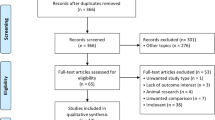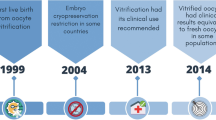Abstract
Purpose
This study investigated the safety and effectiveness of oocyte vitrification by comparing the clinical pregnancy and perinatal outcomes between transfer cycles of vitrified oocytes and those of vitrified embryos.
Methods
A retrospective cohort study was conducted to analyze the clinical data of patients who underwent cleavage-stage embryo transfer at the Department of Reproductive Medicine between January 2011 and June 2021. Seventy-seven transfer cycles of fresh cleavage-stage embryos developed from vitrified-thawed oocytes (oocyte vitrification group) and 2170 transfer cycles of vitrified-thawed cleavage-stage embryos developed from fresh oocytes (embryo vitrification group) were included. Further, 293 cases were selected from the embryo vitrification group after applying propensity score matching at 1:4. The primary outcomes were miscarriage rate, live birth rate, and neonatal birth weight.
Results
No statistically significant differences were observed in the baseline data, pregnancy, perinatal outcomes, or neonatal outcomes for either singleton or twin births between the two groups after matching. Backwards stepwise regression was used to analyze the length of gestation. The age of female participants (β = − 0.410, 95% CI = − 1.339 ~ − 0.620, P < 0.001) had a statistically significant effect.
Conclusion
Oocyte vitrification results in similar clinical pregnancy and perinatal outcomes as does embryo vitrification; hence, it is a relatively safe assisted reproductive technique.
Similar content being viewed by others
Data availability
Data presented in this study are available on request from the corresponding authors.
References
Chen C. Pregnancy after human oocyte cryopreservation. Lancet. 1986;1:884–6.
Kuleshova L, Gianaroli L, Magli C, Ferraretti A, Trounson A. Birth following vitrification of a small number of human oocytes: case report. Hum Reprod. 1999;14:3077–9.
Practice Committees of the American Society for Reproductive Medicine and the Society for Assisted Reproductive Technology. Mature oocyte cryopreservation: a guideline. Fertil Steril. 2013;99:37–43.
Meirow D, Nugent D. The effects of radiotherapy and chemotherapy on female reproduction. Hum Reprod Update. 2001;7:535–43.
Fabbri R, Porcu E, Marsella T, Rocchetta G, Venturoli S, Flamigni C. Human oocyte cryopreservation: new perspectives regarding oocyte survival. Hum Reprod. 2001;16:411–6.
Oktay K, Cil AP, Bang H. Efficiency of oocyte cryopreservation: a meta-analysis. Fertil Steril. 2006;86:70–80.
Alpha Scientists in Reproductive Medicine and ESHRE Special Interest Group of Embryology. The Istanbul consensus workshop on embryo assessment: proceedings of an expert meeting. Hum Reprod. 2011;26:1270–83.
Achermann APP, Pereira TA, Esteves SC. Microdissection testicular sperm extraction (micro-TESE) in men with infertility due to nonobstructive azoospermia: summary of current literature. Int Urol Nephrol. 2021;53:2193–210.
AbdelHafez F, Bedaiwy M, El-Nashar SA, Sabanegh E, Desai N. Techniques for cryopreservation of individual or small numbers of human spermatozoa: a systematic review. Hum Reprod Update. 2009;15:153–64.
Practice Committee of American Society for Reproductive Medicine. Fertility preservation in patients undergoing gonadotoxic therapy or gonadectomy: a committee opinion. Fertil Steril. 2013;100:1214–23.
Dolmans M-M, Donnez J. Fertility preservation in women for medical and social reasons: oocytes vs ovarian tissue. Best Pract Res Clin Obstet Gynaecol. 2021;70:63–80.
Practice Committee of the American Society for Reproductive Medicine. Fertility preservation in patients undergoing gonadotoxic therapy or gonadectomy: a committee opinion. Fertil Steril. 2019;112:1022–33.
Dolmans MM, Cordier F, Amorim CA, Donnez J, Vander Linden C. In vitro Activation Prior to Transplantation of Human Ovarian Tissue: Is It Truly Effective? Front Endocrinol (Lausanne). 2019;10:520.
Rienzi L, Gracia C, Maggiulli R, LaBarbera AR, Kaser DJ, Ubaldi FM, Vanderpoel S, Racowsky C. Oocyte, embryo and blastocyst cryopreservation in ART: systematic review and meta-analysis comparing slow-freezing versus vitrification to produce evidence for the development of global guidance. Hum Reprod Update. 2017;23(2):139–55.
Nikas G, Develioglu OH, Toner JP, Jones HW. Endometrial pinopodes indicate a shift in the window of receptivity in IVF cycles. Hum Reprod. 1999;14:787–92.
Shapiro BS, Daneshmand ST, Garner FC, Aguirre M, Hudson C, Thomas S. Evidence of impaired endometrial receptivity after ovarian stimulation for in vitro fertilization: a prospective randomized trial comparing fresh and frozen–thawed embryo transfer in normal responders. Fertil Steril. 2011;96:344–8.
Shapiro BS, Daneshmand ST, Restrepo H, Garner FC, Aguirre M, Hudson C. Matched-cohort comparison of single-embryo transfers in fresh and frozen-thawed embryo transfer cycles. Fertil Steril. 2013;99:389–92.
Maheshwari A, Raja EA, Bhattacharya S. Obstetric and perinatal outcomes after either fresh or thawed frozen embryo transfer: an analysis of 112,432 singleton pregnancies recorded in the Human Fertilisation and Embryology Authority anonymized dataset. Fertil Steril. 2016;106:1703–8.
Ho JR, Woo I, Louie K, Salem W, Jabara SI, Bendikson KA, Paulson RJ, Chung K. A comparison of live birth rates and perinatal outcomes between cryopreserved oocytes and cryopreserved embryos. J Assist Reprod Genet. 2017;34(10):1359–66.
Cobo A, Serra V, Garrido N, Olmo I, Pellicer A, Remohí J. Obstetric and perinatal outcome of babies born from vitrified oocytes. Fertil Steril. 2014;102:1006-1015.e4.
Seshadri S, Saab W, Exeter H, Drew E, Petrie A, Davies M, et al. Clinical outcomes of a vitrified donor oocyte programme: a single UK centre experience. Eur J Obstet Gynecol Reprod Biol. 2018;225:136–40.
Poon LC, Shennan A, Hyett JA, Kapur A, Hadar E, Divakar H, et al. The International Federation of Gynecology and Obstetrics (FIGO) initiative on pre-eclampsia: a pragmatic guide for first-trimester screening and prevention. Int J Gynaecol Obstet. 2019;145:1–33.
Sigalos GΑ, Triantafyllidou O, Vlahos NF. Novel embryo selection techniques to increase embryo implantation in IVF attempts. Arch Gynecol Obstet. 2016;294:1117–24.
Chih HJ, Elias FTS, Gaudet L, Velez MP. Assisted reproductive technology and hypertensive disorders of pregnancy: systematic review and meta-analyses. BMC Pregnancy Childbirth. 2021;21:449.
Pan Y, Wu R, Wang Z, Li X, Gao S, Shi Y. The effect of freezing twice during assisted reproductive technology on perinatal and neonatal outcomes. Biomed Res Int. 2022;2022:1–8.
Hu L, Du J, Lv H, Zhao J, Chen M, Wang Y, et al. Influencing factors of pregnancy loss and survival probability of clinical pregnancies conceived through assisted reproductive technology. Reprod Biol Endocrinol. 2018;16:74.
Yang AM, Xu X, Han Y, Wei JJ, Hao GM, Cui N, Zhao ZM, Wang W, Huang X. Risk Factors for Different Types of Pregnancy Losses: Analysis of 15,210 Pregnancies After Embryo Transfer. Front Endocrinol (Lausanne). 2021;12:68323.
Fei Z, Xin X, Fei H, Yuechong C. Meta-analysis of the use of hyaluronic acid gel to prevent intrauterine adhesions after miscarriage. Eur J Obstet Gynecol Reprod Biol. 2020;244:1–4.
Iussig B, Maggiulli R, Fabozzi G, Bertelle S, Vaiarelli A, Cimadomo D, et al. A brief history of oocyte cryopreservation: arguments and facts. Acta Obstet Gynecol Scand. 2019;98:550–8.
Acknowledgements
The authors would like to express their gratitude to all the medical staff of Reproductive Medicine Department of the Third Affiliated Hospital of Zhengzhou University for their support.
Funding
This research was funded by Joint Construction Project of Henan Medical Science and Technology Research Plan (LHGJ20190355, LHGJ20210437), PhD research startup foundation of the Third Affiliated Hospital of Zhengzhou University (2021035), Natural Science Foundation of Henan Province (232300421277).
Author information
Authors and Affiliations
Contributions
Chunyan Shen contributed to conception and design of the study. Shanshan Du organized the database. Jianrui Zhang performed the statistical analysis. Chunyan Shen and Shanshan Du wrote the first draft of the manuscript and revised the article. All authors read and approved the final manuscript.
Corresponding author
Ethics declarations
Ethics approval
The study was approved by the Ethics Committee of The Third Affiliated Hospital of Zhengzhou University (review number: 2022-(pre)103).
Consent
Informed consent was not applicable since the present study is a retrospective data analysis. Written informed consent for participation was not required for this study in accordance with the national legislation and the institutional requirements.
Competing interests
The authors declare no competing interests.
Additional information
Publisher's Note
Springer Nature remains neutral with regard to jurisdictional claims in published maps and institutional affiliations.
Rights and permissions
Springer Nature or its licensor (e.g. a society or other partner) holds exclusive rights to this article under a publishing agreement with the author(s) or other rightsholder(s); author self-archiving of the accepted manuscript version of this article is solely governed by the terms of such publishing agreement and applicable law.
About this article
Cite this article
Du, S., Shen, C. & Zhang, J. A comparative analysis of the clinical pregnancy and perinatal outcomes between oocyte vitrification and embryo vitrification based on the propensity score matching method. J Assist Reprod Genet 41, 875–883 (2024). https://doi.org/10.1007/s10815-024-03055-3
Received:
Accepted:
Published:
Issue Date:
DOI: https://doi.org/10.1007/s10815-024-03055-3




